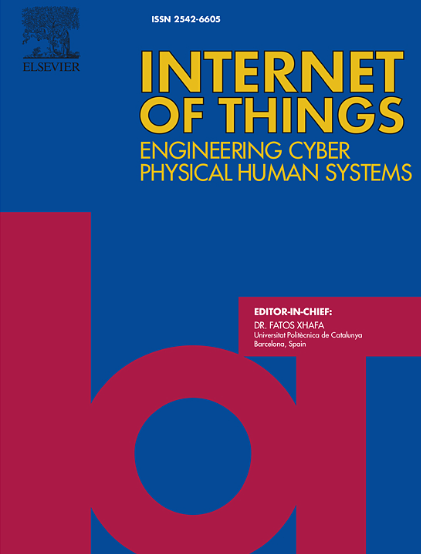A novel hybrid metaheuristic method for efficient decentralized IoT network layouts
IF 6
3区 计算机科学
Q1 COMPUTER SCIENCE, INFORMATION SYSTEMS
引用次数: 0
Abstract
This paper introduces a Hybrid Genetic Particle Swarm Optimization (HGPSO) method focusing on optimal and efficient sensor deployment in Wireless Sensor Networks (WSNs) and Decentralized IoT (DIoT) networks. Effective sensor placement in these networks necessitates the simultaneous optimization of numerous conflicting goals, such as maximizing coverage, ensuring connectivity, minimizing redundancy, and improving energy economy. Traditional optimization techniques and single metaheuristic algorithms frequently encounter these difficulties, demonstrating premature convergence or inadequately balancing exploration and exploitation phases. The suggested HGPSO effectively combines the advantageous features of Genetic Algorithm (GA) and Particle Swarm Optimization (PSO) to overcome these limitations. The strong global exploration capabilities of GA, which successfully preserve variety and avert premature convergence, are integrated with the swift local exploitation and convergence attributes of PSO. A new multi-objective fitness function specifically designed for sensor deployment issues is created, facilitating the effective handling of trade-offs between conflicting objectives. The efficacy of the HGPSO approach is meticulously assessed in seven consistent situations and practical applications, encompassing environments with intricate impediments. A comparative examination is performed against six prominent metaheuristic algorithms acknowledged in literature. Results indicate that HGPSO regularly surpasses these competing methods across all assessment categories. Regarding average fitness values, HGPSO exceeds POHBA by 14 %, MAOA by 20 %, IDDT-GA by 21 %, EFSSA by 29 %, CFL-PSO by 35 %, and OBA by 45 %. These findings underscore HGPSO's exceptional theoretical framework and validate its practical relevance for extensive, real-world IoT implementations. By adeptly utilizing the exploration capabilities of GA and the exploitation strengths of PSO, HGPSO becomes a highly versatile and resilient optimization framework, making substantial contributions to addressing the deployment issues of next-generation IoT and WSN.
一种新的混合元启发式方法用于高效分散物联网网络布局
针对无线传感器网络(WSNs)和分散物联网(DIoT)网络中传感器的优化和高效部署问题,提出了一种混合遗传粒子群算法(HGPSO)。在这些网络中有效地放置传感器需要同时优化许多相互冲突的目标,例如最大化覆盖范围、确保连接、最小化冗余和提高能源经济性。传统的优化技术和单一元启发式算法经常遇到这些困难,表现出过早收敛或不充分平衡勘探和开发阶段。该算法有效地结合了遗传算法(GA)和粒子群算法(PSO)的优点,克服了这些局限性。遗传算法具有强大的全局探索能力,既能有效地保持多样性,又能避免过早收敛,这与粒子群算法的快速局部开发和收敛特性相结合。一个新的多目标适应度函数专门为传感器部署问题设计,促进有效处理冲突目标之间的权衡。HGPSO方法的有效性在七个一致的情况和实际应用中进行了细致的评估,包括复杂障碍的环境。比较检查进行了对六个突出的元启发式算法在文献中承认。结果表明,HGPSO在所有评估类别中都经常优于这些竞争方法。就平均适应度值而言,HGPSO比POHBA高14%,比MAOA高20%,比IDDT-GA高21%,比EFSSA高29%,比CFL-PSO高35%,比OBA高45%。这些发现强调了HGPSO卓越的理论框架,并验证了其与广泛的现实世界物联网实施的实际相关性。通过熟练地利用遗传算法的探索能力和粒子群算法的开发优势,HGPSO成为一个高度通用和弹性的优化框架,为解决下一代物联网和WSN的部署问题做出了实质性的贡献。
本文章由计算机程序翻译,如有差异,请以英文原文为准。
求助全文
约1分钟内获得全文
求助全文
来源期刊

Internet of Things
Multiple-
CiteScore
3.60
自引率
5.10%
发文量
115
审稿时长
37 days
期刊介绍:
Internet of Things; Engineering Cyber Physical Human Systems is a comprehensive journal encouraging cross collaboration between researchers, engineers and practitioners in the field of IoT & Cyber Physical Human Systems. The journal offers a unique platform to exchange scientific information on the entire breadth of technology, science, and societal applications of the IoT.
The journal will place a high priority on timely publication, and provide a home for high quality.
Furthermore, IOT is interested in publishing topical Special Issues on any aspect of IOT.
 求助内容:
求助内容: 应助结果提醒方式:
应助结果提醒方式:


